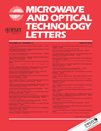Slow-wave high-Q coplanar striplines in CMOS technology and their RLCG model
Abstract
Slow-wave coplanar striplines (S-CPS) have been implemented in the standard AMS 0.35 μm CMOS technology. Compared to conventional coplanar striplines (CPS), at 20 GHz, the proposed S-CPS line has more than 675% increase in quality factor, 54% improvement in the attenuation constant and 72% reduction in the electrical length. The RLCG model has also been extracted and the sources of losses have been identified. © 2012 Wiley Periodicals, Inc. Microwave Opt Technol Lett 54:650–654, 2012; View this article online at wileyonlinelibrary.com. DOI 10.1002/mop.26645




